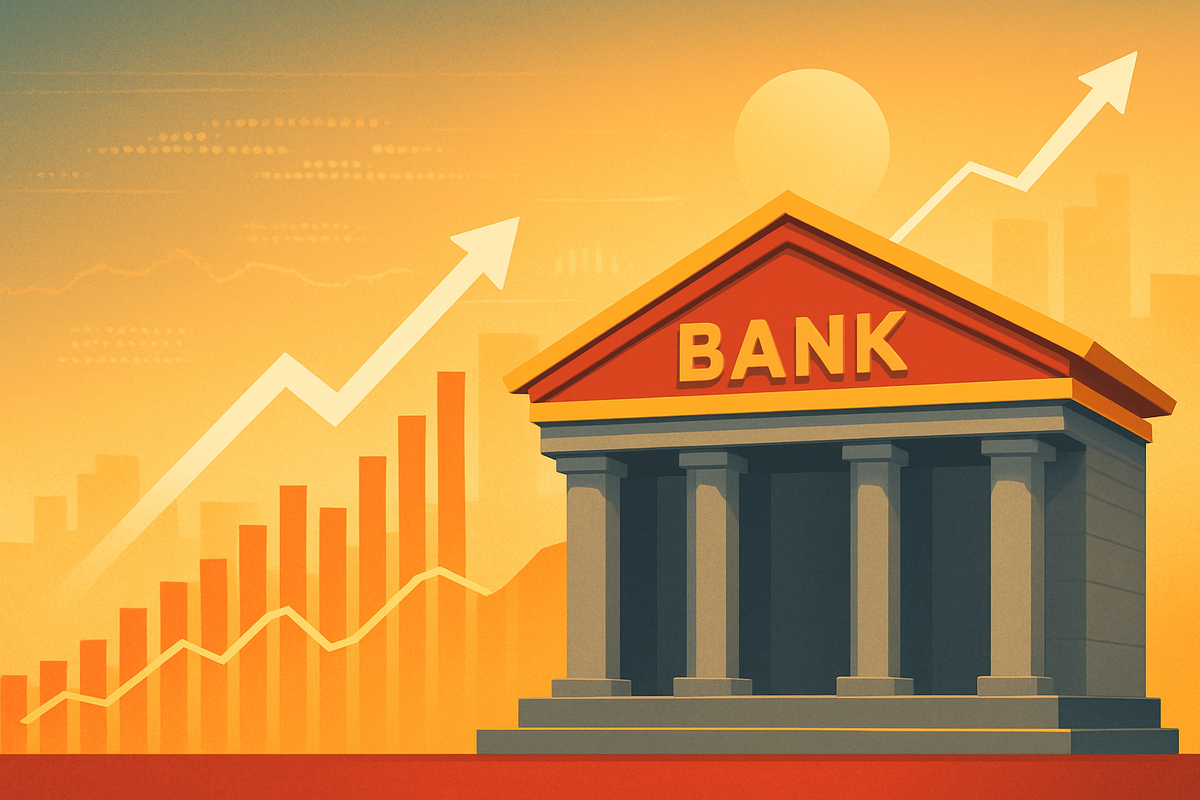
October 14, 2025 – The financial markets are abuzz today with a hypothetical scenario of robust performance from Wells Fargo & Company (NYSE: WFC), signaling a potential wave of optimism cascading across the broader Financials sector. While specific real-time data for this future date is beyond current analytical capabilities, an imagined surge in Wells Fargo's stock price on this day would undoubtedly be interpreted as a powerful indicator of underlying economic strength and a favorable operating environment for major financial institutions.
Such a strong showing from a banking giant like Wells Fargo would immediately suggest a confluence of positive factors, ranging from better-than-expected earnings to an advantageous interest rate landscape. This hypothetical uplift would not only bolster the S&P 500 Financials Index (INDEXSP: .SPSY) but also inject a significant dose of confidence into investor sentiment, potentially setting a positive tone for the entire market.
Dissecting the Hypothetical Drivers of Wells Fargo's Performance
A hypothetical strong performance by Wells Fargo on October 14, 2025, would likely be attributed to several key drivers, reflecting both internal operational successes and broader macroeconomic tailwinds. Foremost among these would be the anticipation or announcement of strong earnings and enhanced profitability. This could stem from robust net interest income (NII), driven by a widening net interest margin (NIM) in a potentially rising or stable interest rate environment, allowing the bank to earn more on its loans relative to its deposit costs. Furthermore, a hypothetical resurgence in investment banking and trading revenues, indicative of increased corporate activity such as mergers and acquisitions (M&A) or new public listings, would significantly contribute to the bank's bottom line.
Beyond direct earnings, a positive credit picture would be paramount. Reduced expectations for loan defaults and a healthy growth in loan portfolios would signal financial stability and prudent risk management. Operational efficiencies, such as a well-managed cost-to-income ratio, would further underscore the bank's ability to maximize profitability. The broader economic climate would also play a crucial role; a resilient economy with steady consumer spending and corporate investment would directly translate into increased demand for banking services and improved asset quality. Finally, a favorable regulatory outlook, perhaps involving relaxed capital requirements or a more supportive policy stance, could unlock additional capital for deployment, enhancing shareholder returns and boosting investor confidence in Wells Fargo's future prospects.
Industry Ripple Effects: Winners and Losers
A significant positive movement by Wells Fargo would send ripples throughout the banking industry. Major competitors like JPMorgan Chase & Co. (NYSE: JPM), Bank of America Corporation (NYSE: BAC), and Citigroup Inc. (NYSE: C) would likely experience a sympathetic uplift. Investors often view these large, diversified banks as a collective, and positive news for one bellwether can signal a healthier environment for all. This is particularly true if the drivers of Wells Fargo's hypothetical success are systemic, such as a steepening yield curve or an improved economic outlook, which would benefit all institutions with significant lending operations. Regional banks, such as U.S. Bancorp (NYSE: USB) or PNC Financial Services Group Inc. (NYSE: PNC), would also likely see gains, albeit potentially more moderated, as broader optimism for the financial sector permeates the market.
Conversely, the "losers" from such an event are less direct but still identifiable. Companies that thrive in an environment of financial uncertainty or distress, such as certain distressed asset managers or niche lenders that capitalize on tighter credit conditions, might see their relative appeal diminish. Additionally, a strong banking sector, particularly if driven by rising interest rates, could put pressure on highly leveraged companies in other sectors by increasing their borrowing costs. Fintech companies that offer alternative lending or payment solutions might also face increased competition if traditional banks are perceived as more robust and innovative. However, the overall sentiment would likely be overwhelmingly positive for the financial ecosystem, with the benefits far outweighing any minor setbacks for peripheral players.
Broader Significance: Trends, Regulations, and History
A hypothetical surge in Wells Fargo's stock on October 14, 2025, would resonate deeply within broader industry trends, affirming the enduring importance of traditional banking institutions even amidst rapid technological evolution. This event would underscore that fundamental economic health, driven by factors like interest rates, loan growth, and credit quality, remains paramount for the financial sector. It could signal a period where the financial sector, often seen as cyclical, is entering a more robust phase, potentially attracting capital that might have previously flowed into growth-oriented technology stocks. The event would also highlight the sector's sensitivity to macroeconomic indicators; strong bank performance is often a lagging or coincident indicator of overall economic vitality.
From a regulatory standpoint, such a strong showing might influence ongoing discussions. If banks are demonstrating robust health and profitability, regulators might feel less pressure to impose additional stringent capital requirements, potentially leading to a more stable and predictable regulatory environment. Conversely, sustained strong performance could also draw renewed scrutiny regarding consumer protection and systemic risk, particularly if profitability is perceived to be driven by aggressive lending practices or excessive risk-taking. Historically, periods of strong bank performance have often preceded either economic booms or, in some cases, periods of increased regulatory oversight following perceived excesses. For instance, the post-2008 era saw significant regulatory tightening, while periods of sustained economic growth have often correlated with strong bank earnings. This hypothetical event would serve as a reminder of the delicate balance between fostering growth and ensuring financial stability.
What Comes Next: Strategic Shifts and Market Opportunities
Looking ahead from this hypothetical strong performance by Wells Fargo, both short-term and long-term possibilities emerge for the financial sector. In the short term, sustained positive momentum could lead to increased investor confidence, driving further capital into financial stocks and potentially prompting analysts to upgrade their ratings for other major banks. This could create a self-reinforcing cycle of optimism, especially if accompanied by positive economic data. Banks themselves might feel emboldened to pursue strategic pivots, such as increasing lending activities, expanding into new markets, or accelerating investments in technology to further enhance efficiency and customer experience. Mergers and acquisitions within the financial sector could also pick up, as stronger balance sheets provide the impetus for consolidation and market share expansion.
In the long term, this hypothetical scenario could signal a more fundamental shift in the market's perception of value versus growth. If interest rates remain supportive and economic growth is sustained, financial stocks, often valued for their dividends and stability, could become a more attractive cornerstone of diversified portfolios. Challenges may still emerge, such as persistent inflationary pressures, geopolitical instability, or unexpected shifts in monetary policy. However, a robust banking sector, exemplified by Wells Fargo's hypothetical strong day, would be better positioned to weather these storms. Market opportunities could arise in areas like sustainable finance, digital banking innovations, and personalized financial services, as banks leverage their newfound strength to invest in future growth areas. Investors should watch for continued earnings reports, central bank policy statements, and broader economic indicators to confirm these potential trends.
A Resilient Sector Poised for Growth
The hypothetical strong performance of Wells Fargo on October 14, 2025, serves as a powerful reminder of the financial sector's pivotal role in the economy and its sensitivity to both internal operational excellence and external macroeconomic forces. While purely speculative for this future date, such an event would underscore key takeaways: that robust net interest income, disciplined credit management, and a supportive economic backdrop are fundamental drivers of banking success. It would also highlight the interconnectedness of the financial industry, where the fortunes of one major player can significantly influence the sentiment and performance of its peers and the broader market.
Moving forward, investors should closely monitor several factors. The trajectory of interest rates, particularly the shape of the yield curve, will remain critical for bank profitability. Loan growth across various segments, from consumer to commercial, will indicate the underlying health of the economy. Furthermore, any shifts in regulatory policy or significant technological advancements within the fintech space could either present opportunities or pose challenges to traditional banking models. A sustained period of strong performance by financial giants like Wells Fargo would suggest a resilient sector, potentially poised for continued growth and offering a compelling value proposition in a diversified investment portfolio. The banking industry, as ever, remains a dynamic landscape where adaptability and sound financial management are key to long-term success.
This content is intended for informational purposes only and is not financial advice.





